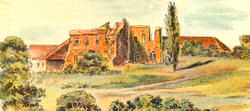Lublin Parish History
LUBLIN Church History
(courtesy of Roland Fogt)The Protestant community in Lublin and the surrounding area has existed since the middle of the 1500's. However, at this time there was no actual church here. The Parish used the church in neighboring Piaski and in the distant town of Nejdorf, across the Bug River (later known as Moscice). In the year 1564 the pastors referred to the parish as the parish of Lublin and Nejdorf.
After a long-time effort, the Protestants of Lublin attained the permission to erect an independent parish in Lublin by the decree of King Stanislaw Poniatowski on the 25th of August 1784. Construction was begun on the church as well as a school, hospital and parsonage. Pastor Tobias Bauch of Nejdorf, who led the project, moved from Nejdorf to the new parish. Construction was finished in 1788 under the direction of August Zynchert. The grateful parishioners created a carved portrait of King Stanislaw, which was set in a finely carved golden frame and hung in a place of honor within the church. From the church in Piaski, the pulpit was brought to the new church. The altar was constructed in the Louis the XV style and includes a depiction of Christ made in 1628.
Church bells were then installed. These bells, made in 1784, were donated by Paul and Sofie Suchodolski from the town of Stryj. During the Russian invasion of 1915, the bells were looted. Thanks to the inscription on the bells they were recovered in 1923. The bells still serve the church to this very day.
The first organ was donated by Jan Piaskowski in 1819 and served the church for almost 100 years. In 1912, the organ was replaced with a newer model made by the E. F. Waicker company. After being refurbished in 1988 by the Oberlinger Company, the organ is still in service today.
Nowhere in this region was a church with so many valuable liturgical objects from the 17th and 18th century. But through the years of war and turmoil they were lost or destroyed. Many of these objects were documented in the " Illustrated Guide to Lublin " published in Warsaw, 1901. Included in this guide are photos of the altar, pulpit and carving of King Stanislaw. Also located within the church are memorial plaques for former ministers and parishioners.
It is noteworthy that this church has served both Lutheran and Evangelical Reformed parishioners. One of the first plaques as you enter on the left is dedicated to Pastor August Diehl. Pastor Diehl was the Protestant Superintendent of the Reformed Church of Congress Poland while at the same time serving as the Protestant administrator of Lublin. In keeping with old Polish tradition, metal plaques of former parishioners adorn the church vestibule leading to the choir loft. The plaques include names of the former Protestant aristocracy. Some of the names listed include; Adam Suchodolski, Fryderyk Wilhelm Hermson - Squire of Czechowka, Jan David Heissler, Jerzy Frifsch, Jan Baranski, Krzystof Korn and Jan Piaskowski. Other plaques include entire Protestant Families who donated to the common good of the parish and region. The Vetter family, for example, were the main donors to the hospital and school, two institutions that still serve the community today. Other institutions, such as the Economics School on Bemardynska Street and the hospital on Staszica Street, benefited from the generosity of such parish families as Krauss, Schollz, Haberlau, Sauter, Jaeger, Piaskowski, Baranski and many others.
The Protestant faithful always put value on higher learning of literature and culture. These themes coincide for a better understanding of the teachings of the Bible and its application to daily life. Donations to the Protestant Lublin schools allowed the students to excel not only in reading, writing and mathematics, but in agriculture, trade and handcraft as well. They instituted numerous libraries, hospices and charitable organizations. In 1913, for example, Jan Piatowski donated a spacious classroom and a library. There were four primary schools of business and 21 church parishioners ran their own farms or schools in the area. Protestant schools were often the only schools in larger rural areas. For example, in the area of Sobieszczany, the only school for its 7,000 inhabitants was Lutheran based.
In the year 1913, the parish counted 8857 members, 410 of whom were from Lublin. The parish included a masonry rectory, three canonical houses, a general hospice, 2 acres of land and a garden in Belzyce. Also included were 3 smaller churches in the outlying areas, 4 elementary schools, 21 smaller houses of worship with schoolrooms and lay clergy living quarters, 166 acres of arable farmland and 40 cemeteries, three of which were in Lublin.
During World War I, the parish experienced severe devastation. Church buildings were destroyed and many parishioners were deported. As mentioned earlier, the church bells were looted. The devastation resulted in only 519 remaining parishioners in 1915, and the parish began to fall into disrepair. With the end of World War I and the onset of Polish independence, the parish began to revive. In 1919 the church records indicated 5,051 parishioners. The parish began to develop again and many of the faithful were recognized and awarded for their defense of their homeland.
In 1934, under the veteran leadership of Dr. Alexander Schoneich and Bronislava Vetter, the Society of Protestant Youth was formed. Dr. Schoneich served as honorary chairperson, and Albert Froelich as chairman. Bronislava Vetter and Jan Krausse were responsible for administration of services. It is fortunate that the parish was able to reestablish itself with veteran parishioners in key positions of leadership.
In 1922, the parish church was once more listed as an important site in the city of Lublin. Also of importance were the numerous gravesites that the parish had established in its cemetery, which was first begun in 1898. It was during World War 2 that the parish experienced the worst devastation of its history. Ministers and parishioners alike were imprisoned. It was on October 3rd, 1939 that the Nazis arrested Bishop Juliusz immediately after holding services. The Polish - Protestant parishes ceased to exist. As result of the war, the parish experienced unimaginable losses of life and property. Church documents, certificates and holy objects were lost and destroyed. The church buildings fell victim along with the parish itself.
In 1944, as the war drew to a close, a small group of the Lublin Protestant faithful began to reestablish the parish, both spiritually and physically. On Christmas Eve of this year, Fr. Rysard Trenkler from Warsaw held a Polish church service in Lublin. In 1945, the former Dachau inmate Waldemar Lucer became the first Protestant minister of the Lublin parish. Since then, a small group of the Protestant faithful from Lublin and the surrounding area have carried on with great difficulty preserving their poor parish and church. Fortunately for the parish, the following members of the city council were parishioners as well: Edward Schoitz (surgeon), Gustav Haberlau (pharmacist), Karol Freybeig (businessman).
Although the church succeeded to revive, it was a time of severe disadvantage for the parish. Many of its former parishioners were scattered around the world and the parish did not recover its former property and holdings. In the past years, particularly since 1976, important repairs and renovations have been initiated, especially that of the church organ. The life of the parish itself has intensified. It has succeeded not only in stopping the membership decline, it has begun a slight increase. The history of the parish is being revived and important tasks, such as the church cemetery gravesite categorizing and refurbishing are being accomplished. Parish members are attending international conferences and meetings of the Protestant faith. The church has welcomed representatives of the Roman Catholic faith as well as missionaries and foreign preachers who have spoken to the faithful. Ecumenical church services and evening-prayer singings take place. Under the leadership of Sylwia Irgowa, district council leader, the work of the Ecumenical Commission of Christian Women has had an excellent impact. There is also community - orientated activities for the parishioners were they can work for the common good of the community in a spiritually beneficial and wholesome environment. Outside of church - sponsored activities, the parish also makes available their prayer house for theater groups and music concerts. The parish is open to Christians both here and abroad for ecumenical cooperation.
Ministers of the Lublin Parish:
1) Pastor Tobiasz Bauch, 1784 - 1795
2) Pastor Jakub Glass, 1795 - 1821
3) Pastor Jan Jerzy Karge, 1821 - 1837
4) Pastor Karol Jozef Jonschcr, 1838 - 1884
5) Pastor Edmund Schulz, 1884 - 1888
6) Pastor/Superintendent Dr. Aleksander Schoneich, 1888 - 1939
7) Pastor/Bishop Dr. Juliusz Bursche, 9/6/1939 - 10/03/ 1939
8) Pastor Gerhard Richter, 7/22/1939 - Sep 1944
9) Pastor Waldemar Lucer, 1945 - 1955
10) Pastor Rudolf Mrowiec, 1955 - 1957
11) Pastor Bogustaw Wittenberg, 1957 - 1967
( It was during this era that the parishes of Lublin and Radom were combined with Radom serving as the pastors residency )
12) Pastor Jan Hause, 1967 - 1976
13) Pastor Jan Szklorz, 1976 - 1995
14) Pastor Roman Pracki, 1995 -
( Pastor Pracki is the first pastor in Lublin since the end of World War 2 to serve in the position of "Probst")


